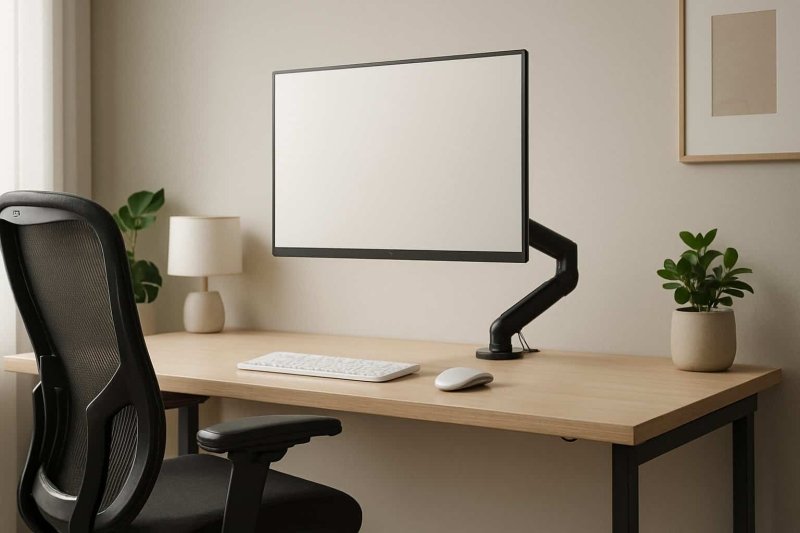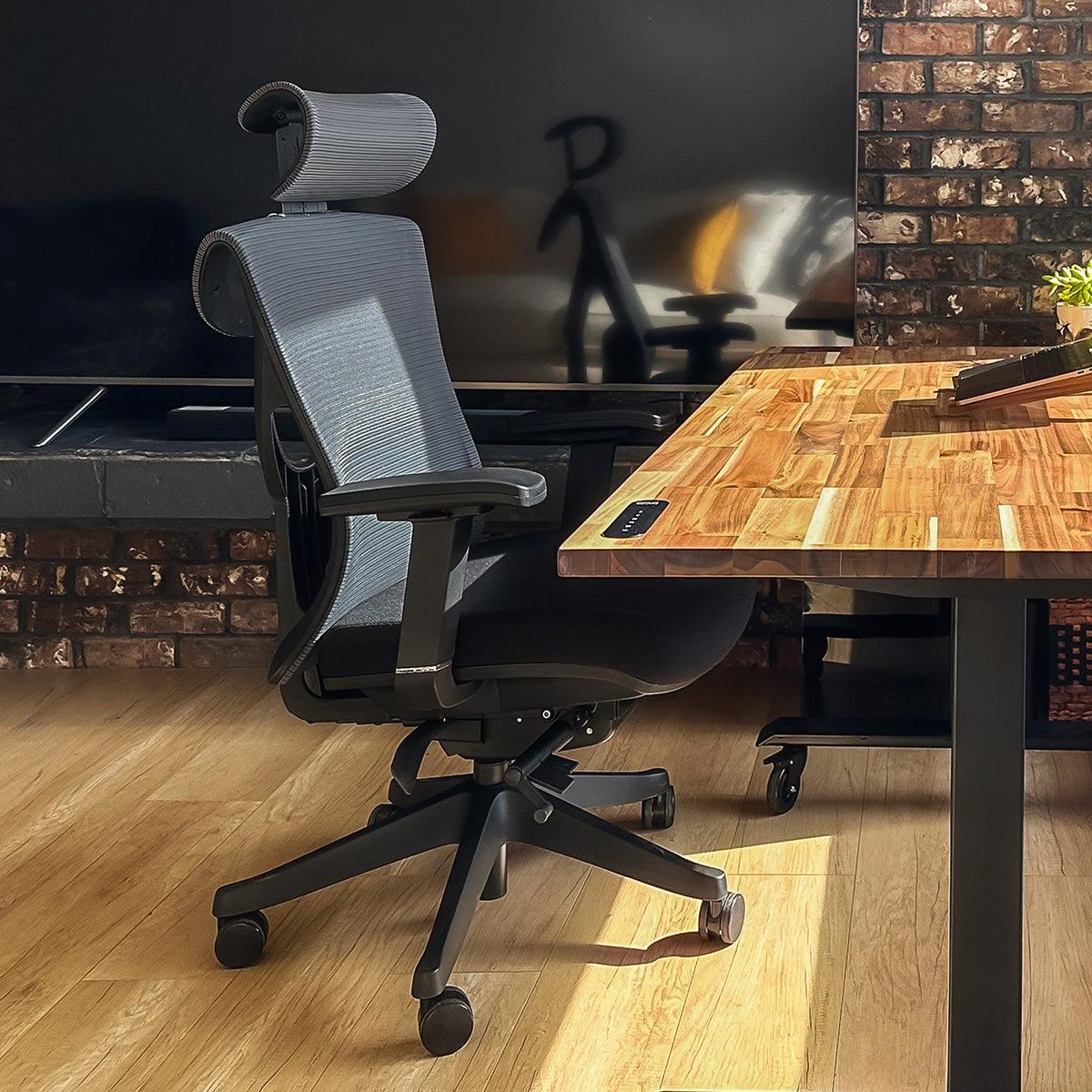
Ergonomic Desk Setups for Neck Pain Prevention Tips and Tricks
Enzo NaparatoShare
Ergonomic desk setups are essential for preventing neck pain, a common issue among office workers. Most people who work at desks experience neck pain due to poor ergonomics. Neck pain can be caused by poor posture, sitting for extended periods, and incorrect desk and chair height.

Fortunately, there are several ways to optimize your workspace by finding the average desk height to reduce the strain on your neck and prevent pain.
Key Takeaways
-
Understanding ergonomics and neck pain is crucial for preventing discomfort and soreness.
-
Optimizing your chair and desk for neck support is essential for preventing neck pain.
-
Incorporating movement and breaks into your routine can help prevent neck pain caused by prolonged sitting.
Understanding Ergonomics and Neck Pain
Neck pain, also referred to as tech neck in the modern workspace, is a common problem, and back and neck pain affect many people who work at a desk for extended periods of time. Lifestyle habits, daily choices, and spending long hours sitting at a desk and using digital devices can affect the development and prevention of neck pain. Patients experiencing persistent neck pain should consider consulting a healthcare professional.
The Impact of Poor Posture on Neck Health
Poor posture is a leading cause of tech neck symptoms and back pain, and it can be caused by a variety of factors, including the wrong chair height, improper monitor placement, or poor keyboard and mouse placement.
Maintaining proper posture is a key factor in preventing neck pain and related issues. When the neck is not in a neutral position, the muscles have to work harder to support the weight of the head, which can lead to muscle fatigue and pain. Simply sitting straight may not be enough; a slightly reclined position with good lumbar support is often recommended to reduce strain on the neck and spine.
Over time, poor posture can also cause spinal misalignment, which can lead to chronic pain and other health problems. Strengthening the muscles that support the neck and back is important for maintaining good posture and preventing neck pain.
Essential Ergonomic Principles for Desk Setups
Ergonomics is the science of designing workspaces to fit the needs of the worker. When it comes to desk setups, there are several essential ergonomic principles to keep in mind to prevent neck pain and other health problems.
-
Chair height: The chair should be adjusted so that the feet are flat on the floor and the knees are at a 90-degree angle. The chair should also provide adequate lumbar support to maintain a neutral spine position, and supports the spine, neck, and posture to prevent discomfort during long periods of sitting.
-
Monitor placement: The top of the monitor should be at or slightly below eye level to prevent neck strain. The monitor should also be positioned at arm’s length to reduce eye strain.
-
Keyboard and mouse placement: The keyboard and mouse should be positioned so that the elbows are at a 90-degree angle and the wrists are in a neutral position. Keeping your elbows close to your body can help reduce strain. This can help prevent wrist strain and carpal tunnel syndrome. Using a wrist rest is also recommended to maintain proper wrist alignment and reduce strain during keyboard and mouse use.
Following these ergonomic principles can help you create a comfortable and healthy workspace that can help prevent neck pain and other health problems.
Optimizing Your Chair and Desk to Address Tech Neck
Proper chair and desk setup are critical in preventing neck pain. In this section, we will discuss how to choose the right office chair, set the correct desk height, and the role of footrests in maintaining posture. It is also important to ensure your legs are comfortably supported and positioned flat on the floor or on a footrest to prevent discomfort during long periods of sitting.
Choosing the Right Office Chair

The right ergonomic chair is essential in preventing neck pain. A good chair should have lumbar support, adjustable armrests, and a comfortable seat.
The lumbar support helps maintain the natural curve of the lower back, which reduces the risk of lower back pain. The adjustable armrests allow the user to rest their arms comfortably, reducing the strain on the neck and shoulders. Meanwhile, a comfortable seat with adequate padding helps reduce pressure points, which can cause discomfort.
Additionally, engaging your core muscles while sitting can help maintain proper posture and reduce strain on your back and neck. Strengthening these core muscles, including the deep abdominal and glute muscles, helps stabilize the spine and supports overall comfort during extended periods of sitting.
Setting the Correct Desk Height

Setting the correct desk height is crucial in maintaining good posture and prevent tech neck. The desk height should be such that the user's arms are at a 90-degree angle when typing.
An ergonomic posture and workspace setup enables you to keep your computer monitor at eye level so you don’t have to bend your neck forward. Sit with your back straight, shoulders relaxed, and feet flat on the floor.
Take regular standing breaks to relieve tension and promote blood flow, and try to avoid sitting in one position for long periods. Simple neck stretches and gentle movements throughout the day can also help reduce stiffness and support healthy neck muscles.
The Role of Footrests in Maintaining Posture
Footrests play an essential role in maintaining good posture. A footrest helps keep the feet flat on the ground, which reduces the pressure on the lower back.
When the feet are flat on the ground, it helps maintain the natural curve of the lower back, reducing the risk of lower back pain. A footrest also helps reduce the strain on the neck and shoulders by maintaining the correct posture.
Computer and Accessory Placement to Reduce Strain
Proper placement of computer accessories can help reduce strain on the neck, shoulders, and wrists. Changing positions regularly throughout the day is important to reduce strain and promote better posture. Here are some tips to help you achieve an ergonomic desk setup that can prevent neck pain:
Monitor Positioning for Eye Level Alignment
The height and distance of the computer screen are important factors in preventing neck pain. The top of the monitor should be at or slightly below eye level, and the distance between the eyes and the screen should be about an arm's length away.
To achieve this, use a monitor stand or adjust the height of the monitor using the built-in stand. Alternatively, you can use a monitor arm to adjust the height and distance of the screen.
Keyboard and Mouse Placement for Wrist Health
The keyboard and mouse should be placed in a way that allows the wrists to remain in a neutral position.
The wrists should not be bent up or down or twisted to the side. To achieve this, place the keyboard and mouse on a flat surface that is at elbow height.
Consider using an ergonomic keyboard and mouse that are designed to reduce strain on the wrists.
Using Laptop Stands and Document Holders
Laptops are not designed for extended use and can cause strain on the neck and shoulders. To prevent this, use a laptop stand to raise the screen to eye level and use an external keyboard and mouse.
A document holder can also be used to keep documents at eye level and reduce strain on the neck.
Additionally, consider using a keyboard tray to keep the keyboard at the correct height and angle. This can help reduce strain on the shoulders and neck.
Incorporating Movement and Breaks into Your Routine
Sitting at a desk for extended periods can cause neck pain, stiffness, and other health problems. Incorporating movement and breaks into your routine can help prevent these issues and improve your overall health and productivity. During breaks, try walking around the office or your home to improve circulation and reduce muscle tension.
Alternating between sitting and work standing throughout the day, also known as active sitting, can also help reduce neck and back strain. Even holding stretches or exercises for a few seconds can provide noticeable benefits.
Stretching and Exercise for Desk Workers
Stretching can help improve flexibility, reduce stiffness, and prevent muscle imbalances that can lead to neck pain. Shoulder blade squeezes are an effective exercise to strengthen the upper back and improve posture, helping to counteract the effects of prolonged device use.

Simple exercises such as shoulder rolls, neck stretches, and chest stretches can be done at your desk and can help alleviate neck pain.
In addition to stretching, incorporating exercise into your routine can also help prevent neck pain. Exercise can help improve circulation, strengthen muscles, and reduce stress, all of which can contribute to better overall health and reduced neck pain. Regular stretching and exercise can help fix tech neck by improving posture and reducing strain on your neck and shoulders.
If possible, consider incorporating a standing desk into your home office or workspace. Standing can help improve circulation, reduce stiffness, and alleviate neck pain. If a standing desk is not an option, consider taking frequent breaks to stand up and stretch.
If neck pain persists, seeking relief through manual therapy, physical therapy, or consulting a physical therapist may be beneficial. These professional treatments can help address persistent pain, improve posture, and support long-term recovery from tech neck.
Getting Rid of Neck Pain Through Office Ergonomics
Understanding ergonomics and neck pain is the first step in preventing discomfort and soreness. Optimizing your ergonomic chair and desk for neck support is crucial for preventing neck pain. Your chair should be adjustable to ensure that your feet can rest flat on the ground, and your knees are at a 90-degree angle.
The desk should be at a comfortable height, so your forearms are parallel to the ground while typing. Additionally, investing in an ergonomic office chair with neck and lumbar support can help prevent neck pain, promote good posture, and improve your overall comfort. Make sure you have enough space in your workspace to accommodate ergonomic furniture and allow for proper adjustments.